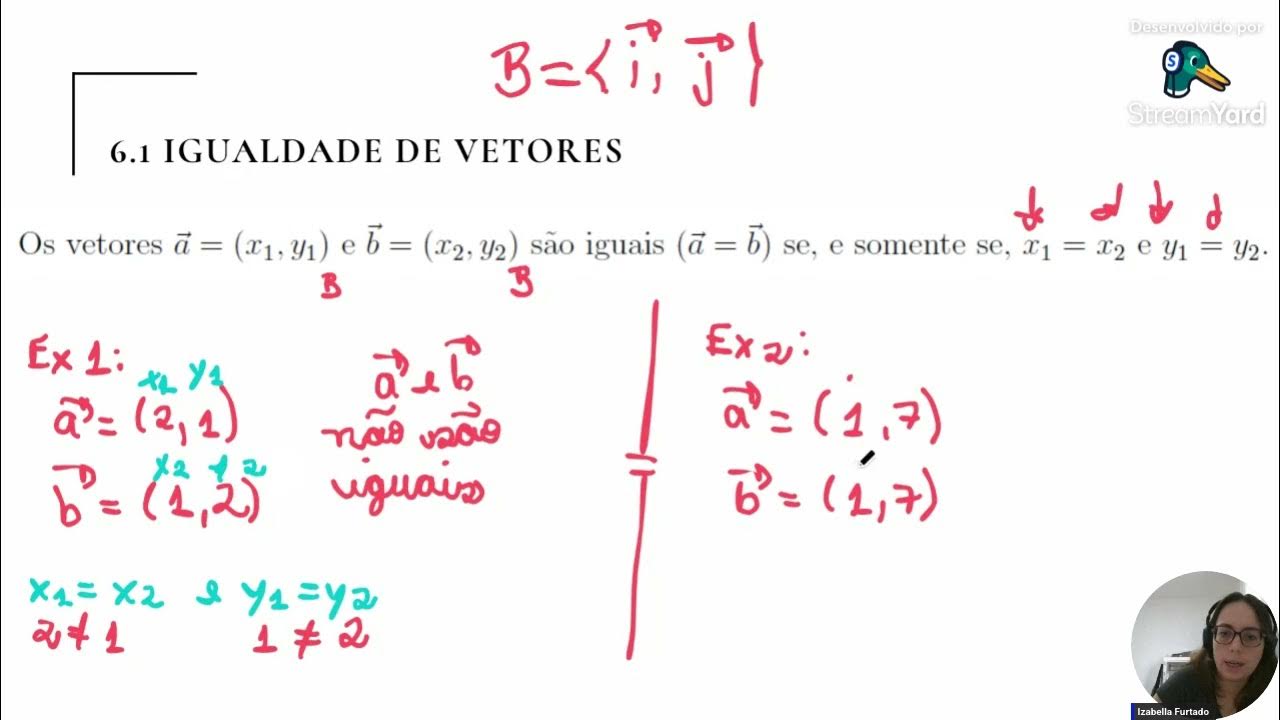Linear combinations, span, and basis vectors | Chapter 2, Essence of linear algebra
Summary
TLDRThis video delves into the concept of vector coordinates, representing vectors as linear combinations of basis vectors. It explores how any 2D vector can be expressed as a sum of scaled versions of the standard basis vectors (i and j). The notion of span is introduced, which represents all possible linear combinations of a set of vectors. Linear independence and dependence are discussed, leading to the definition of a basis as a set of linearly independent vectors that span the space. The video provides insightful visualizations and thought-provoking puzzles, fostering a deeper understanding of these fundamental linear algebra concepts.
Takeaways
- 😀 Vector coordinates represent vectors as pairs of numbers, with each coordinate acting as a scalar that stretches or squishes basis vectors (i-hat and j-hat in 2D).
- 🤔 Any pair of 2D vectors (except when they are co-linear) can span the entire 2D plane through linear combinations, while co-linear vectors span only a line.
- ➕ Linear combinations involve scaling vectors by scalars and adding them together, enabling the construction of new vectors from a set of basis vectors.
- 🌐 The span of a set of vectors is the collection of all possible vectors that can be represented as linear combinations of those vectors.
- 🧭 Linearly independent vectors are those that each contribute a new dimension to the span, while linearly dependent vectors are redundant and can be expressed as linear combinations of the others.
- ✨ A basis is a set of linearly independent vectors that can span the entire space through linear combinations.
- 🔢 Different choices of basis vectors lead to different coordinate systems for representing vectors numerically.
- 📐 In 3D, the span of two non-collinear vectors is a flat sheet, while the span of three general vectors can reach the entire 3D space.
- 🌉 The concept of linear combinations and spans provides a way to understand and visualize the relationships between vectors in a space.
- 🧩 Understanding linear independence, span, and basis is fundamental to the study of linear algebra and its applications.
Q & A
What is the purpose of discussing vector coordinates in the video?
-The video discusses vector coordinates to show the connection between pairs of numbers and two-dimensional vectors, and to introduce the concept of basis vectors and linear combinations.
What are the basis vectors i-hat and j-hat, and how are they related to vector coordinates?
-i-hat and j-hat are unit vectors pointing in the x and y directions, respectively. The coordinates of a vector are scalars that scale these basis vectors, and the vector itself is the sum of the scaled basis vectors.
Can we choose different basis vectors other than i-hat and j-hat?
-Yes, we can choose any two non-collinear vectors as the basis vectors for a two-dimensional coordinate system. This will result in a different association between vector coordinates and actual vectors.
What is a linear combination of vectors?
-A linear combination of vectors is obtained by scaling each vector by a scalar and then adding the scaled vectors together.
What is the span of a set of vectors?
-The span of a set of vectors is the set of all possible vectors that can be obtained as linear combinations of those vectors.
What happens to the span of two vectors in 3D space?
-The span of two non-collinear vectors in 3D space is a flat sheet or plane passing through the origin.
How does adding a third vector affect the span in 3D space?
-If the third vector is not in the plane spanned by the first two vectors, then the span becomes the entire 3D space. If the third vector lies in the same plane, the span remains the same.
What does it mean for a set of vectors to be linearly dependent or linearly independent?
-A set of vectors is linearly dependent if one of the vectors can be expressed as a linear combination of the others. If no vector can be expressed as a linear combination of the others, they are linearly independent.
What is the technical definition of a basis for a space?
-A basis of a space is a set of linearly independent vectors that span that space.
Why does the technical definition of a basis make sense, according to the video?
-The video does not explicitly explain why this definition makes sense, but it is likely because a basis should consist of vectors that are not redundant (linearly independent) and can collectively access the entire space (span the space).
Outlines

This section is available to paid users only. Please upgrade to access this part.
Upgrade NowMindmap

This section is available to paid users only. Please upgrade to access this part.
Upgrade NowKeywords

This section is available to paid users only. Please upgrade to access this part.
Upgrade NowHighlights

This section is available to paid users only. Please upgrade to access this part.
Upgrade NowTranscripts

This section is available to paid users only. Please upgrade to access this part.
Upgrade NowBrowse More Related Video
5.0 / 5 (0 votes)





